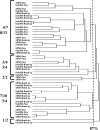Effect of environmental factors and influence of rumen and hindgut biogeography on bacterial communities in steers
- PMID: 21075877
- PMCID: PMC3019729
- DOI: 10.1128/AEM.01289-09
Effect of environmental factors and influence of rumen and hindgut biogeography on bacterial communities in steers
Abstract
Feces from cattle production are considered important sources of bacterial contamination of food and the environment. Little is known about the combined effects of arctic temperatures and fodder tannins on rumen and hindgut bacterial populations. Individual rumen liquor and rectal fecal samples from donor steers fed either alfalfa silage or sainfoin (Onobrychis viciifolia Scop.) silage and water ad libitum were collected weekly on the first three sampling days and fortnightly afterwards. The daily ambient temperatures were registered and averaged to weekly mean temperatures. Steers fed sainfoin silage had lower (P < 0.05) concentrations of branched-chain volatile fatty acids (VFA) than those fed alfalfa silage. All VFA concentrations were higher (P < 0.001) in rumen liquor samples than in fecal samples. The interaction of sample type and diet showed a significant effect (P < 0.05) on the proportions of the bacterial community that were from the phyla Proteobacteria and Verrucomicrobia. Ambient temperature had an indirect effect (P < 0.05) on the phylum Firmicutes, as it affected its proportional balance. The bacterial population diversity in samples appeared to decrease concurrently with the ambient temperature. The phylum Firmicutes explained the first principal component at 64.83 and 42.58% of the total variance in rumen liquor and fecal samples, respectively. The sample type had a larger effect on bacterial communities than diet and temperature. Certain bacterial populations seemed to be better adapted than others to environmentally adverse conditions, such as less access time to nutrients due to higher motility and rate of passage of digesta caused by extreme temperatures, or antimicrobials such as tannins, possibly due to an influence of their biogeographical location within the gut.
Figures




Similar articles
-
Effect of Propionibacterium acidipropionici P169 on the rumen and faecal microbiota of beef cattle fed a maize-based finishing diet.Benef Microbes. 2017 Oct 13;8(5):785-799. doi: 10.3920/BM2016.0145. Epub 2017 Aug 31. Benef Microbes. 2017. PMID: 28856906
-
Composition, spatial distribution, and diversity of the bacterial communities in the rumen of cows fed different forages.FEMS Microbiol Ecol. 2010 Dec;74(3):612-22. doi: 10.1111/j.1574-6941.2010.00977.x. Epub 2010 Nov 2. FEMS Microbiol Ecol. 2010. PMID: 21044097
-
The effects of a probiotic yeast on the bacterial diversity and population structure in the rumen of cattle.PLoS One. 2013 Jul 2;8(7):e67824. doi: 10.1371/journal.pone.0067824. Print 2013. PLoS One. 2013. PMID: 23844101 Free PMC article.
-
Rumen microbial population dynamics during adaptation to a high-grain diet.Appl Environ Microbiol. 2010 Nov;76(22):7482-90. doi: 10.1128/AEM.00388-10. Epub 2010 Sep 17. Appl Environ Microbiol. 2010. PMID: 20851965 Free PMC article.
-
Ruminant Nutrition Symposium: Productivity, digestion, and health responses to hindgut acidosis in ruminants.J Anim Sci. 2011 Apr;89(4):1120-30. doi: 10.2527/jas.2010-3460. J Anim Sci. 2011. PMID: 21415422 Review.
Cited by
-
Impact of feed efficiency and diet on adaptive variations in the bacterial community in the rumen fluid of cattle.Appl Environ Microbiol. 2012 Feb;78(4):1203-14. doi: 10.1128/AEM.05114-11. Epub 2011 Dec 9. Appl Environ Microbiol. 2012. PMID: 22156428 Free PMC article.
-
The Remodeling Effects of High-Concentrate Diets on Microbial Composition and Function in the Hindgut of Dairy Cows.Front Nutr. 2022 Feb 1;8:809406. doi: 10.3389/fnut.2021.809406. eCollection 2021. Front Nutr. 2022. PMID: 35178417 Free PMC article.
-
Fecal microbiota changes associated with dehorning and castration stress primarily affects light-weight dairy calves.PLoS One. 2019 Jan 23;14(1):e0210203. doi: 10.1371/journal.pone.0210203. eCollection 2019. PLoS One. 2019. PMID: 30673718 Free PMC article.
-
Seasonal Shifts in Diet and Gut Microbiota of the American Bison (Bison bison).PLoS One. 2015 Nov 12;10(11):e0142409. doi: 10.1371/journal.pone.0142409. eCollection 2015. PLoS One. 2015. PMID: 26562019 Free PMC article.
-
Comparison of rumen bacterial communities in dairy herds of different production.BMC Microbiol. 2017 Aug 30;17(1):190. doi: 10.1186/s12866-017-1098-z. BMC Microbiol. 2017. PMID: 28854878 Free PMC article.
References
-
- Bach, A., S. Calsamiglia, and M. D. Stern. 2005. Nitrogen metabolism in the rumen. J. Dairy Sci. 88:E9-E21. - PubMed
-
- Baldwin, R. L., and M. J. Allison. 1983. Rumen metabolism. J. Anim. Sci. 57:461-477. - PubMed
-
- Bhandari, S. K., B. Xu, C. M. Nyachoti, D. W. Giesting, and D. O. Krause. 2008. Evaluation of alternatives to antibiotics using an Escherichia coli K88+ model of piglet diarrhea: effects on gut microbial ecology. J. Anim. Sci. 86:836-847. - PubMed
-
- Brooker, J. D., L. A. O'Donovan, I. Skene, K. Clarke, L. Blackall, and P. Muslera. 1994. Streptococcus caprinus sp. nov., a tannin-resistant ruminal bacterium from feral goats. Lett. Appl. Microbiol. 18:313-318.
Publication types
MeSH terms
Substances
LinkOut - more resources
Full Text Sources
Medical

